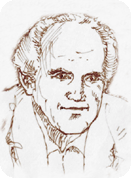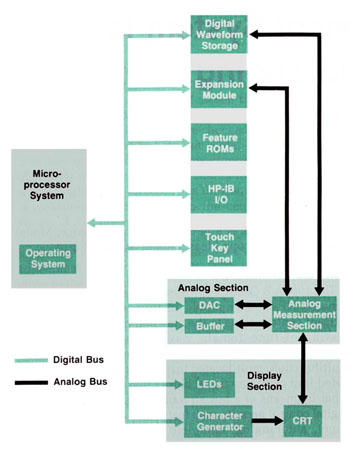The HP 1980,
By Zvonko Fazarinc
Zvonko promised me some story on the HP 1980 oscilloscope when I met him during my trip to Palo Alto in 2007. Here are a few of his recollections of the internal events that preceded the development of that instrument.
I hope this gives you a little insight into what goes on during the early days of conceiving a new instrument.
The HP 1980 Oscilloscope, live, by Zvonko Fazarinc
It was John Young who came to the lab and asked if we could do something about improving the reputation of HP oscilloscopes that was damaged quite badly by Tektronix's claims that our scopes did not trigger. So Barney Oliver and Paul Stoft gave me the responsibility to come up with some innovative ideas about dealing with the whole issue of the oscilloscopes.
By that time the triggering problems have been fixed by Colorado Springs Division but the bad reputation did not go away. After a few consultations with some of my engineers, we have concluded that the technology of A/D converters has not matured to allow a 100MHz digital oscilloscope which was a goal at that time. But we felt that we have to somehow give the oscilloscope an innovative digital signature of the time.
So we have decided to build an analog oscilloscope whose components would be controlled digitally. This was going to give us a digital self calibration capability and a number of other programmable facilities. We filed for and later obtained a patent on the idea. We were conservative in the sense that we did not want to make a big jump from the conventional external control of the instrument. So our proposal was to replace the existing knobs on the oscilloscope by pushbuttons allowing "Up" and "Down" adjustments with results being visible on a digital display next to the pushbuttons.
We created a mockup of the proposed front panel that we were to show to Barney for approval. But he did not like the idea of so many pushbuttons and displays for each separate function. He wanted just one pair of pushbuttons knob and one display and then a another knob switch with which we were to select the function these two buttons will would control. CS Division and I felt very strongly that it would be too big a jump in concept of an oscilloscope to make such a drastic change. The final argument that convinced Barney of our position was when I told him that "the world is not ready for a one key piano with a pitch selector". This response was suggested by one of my engineers.
So we won and now we were faced with getting the whole thing going. We simulated the major parts of this oscilloscope on the minicomputer and made a demonstration for Bill and Dave and for some selected division managers and their engineers. The demonstration was a success and Bill Hewlett said to the CS Division manager that "he should like the idea". To me he said that he would like to see a prototype in a year. I objected strongly because I knew that we would have to design and build 14 never before tested custom analog/digital integrated circuits to build the instrument.
When I tried to explain to Mr. Hewlett that this is not a pocket calculator, which had only one digital chip, he said with a very friendly voice "Zvonko, if you have something better to work on just let me know" and walked away.
He was a tough customer but has later shown good understanding when the project was very promising but already in the third year. After transfer to CS the acceptance of the new technology has advanced to the point where the divisional engineers adopted Barney's idea about the oscilloscope controls. And many years later the true digital oscilloscope became possible when the technology of A/D converters made more progress.
Zvonko Fazarinc
|
Today, the 1980 is 30 years old. In retrospect, with Zvonko's humour and modesty, these fond memories somewhat minimize the extraordinary performance that the conception of such an instrument could represent at that time. The technological innovations integrated into the 1980 have marked the definitive transition from the analog oscilloscope to the digital oscilloscope.
The major part of these concepts which govern the architecture of today's oscilloscope have been invented by the teams who developed the HP 1980.
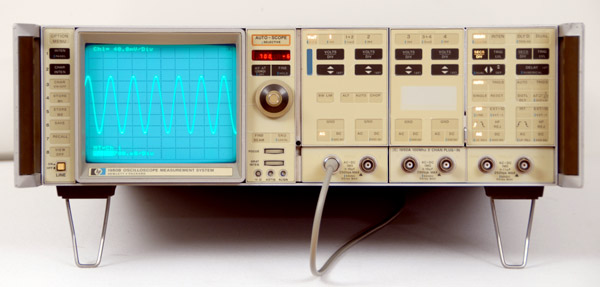 |
| The HP 1980B Oscilloscope |
 |
The HP 1980B Oscilloscope
|
The HP 1980B,
Oscilloscope Measurement System
At its introduction, in 1982, the 1980A/B Oscillosope Measurement System is an automated instrument that makes significant contributions to the viewing, measuring, and processing of time-domain waveforms.
In its basic configuration, the 1980A/B offers two 100-MHz analog measurement channels with 2-mV/div deflection factors, two independent and direct 5-ns/div sweeps, main or delayed trigger view, delta-time and delta-voltage measurements, and a multitude of automated features including Autoscope, which allows the user to obtain a display rapidly without adjusting individual controls.
With the HP-IB interface, the 1980A/B can be combined with other HP-IB-compatible instruments to form a completely automated test system. Because the 1980A/B is fully programmable, test routines can be established, stored, and used repeatedly.
The HP 1980B,
First "Computer Architecture Based" Oscilloscope
With its microprocessor-based computer architecture, the 1980A/B is a multifunction, multifaceted instrument. Internally, it is divided into eight functional blocks that interface with each other by means of a bus structure.
This extensive digital control permits such features as an easy-to-use front panel, autoranging, complete programmability, digital waveform storage, and hardware and firmware expandability. Unlike other oscilloscopes of the time, the 1980A/B's innovative front panel has a single rotary control.
Remotely programmed operation is provided through a standard HP-IB port that interfaces with all functional blocks through the internal bus. All measurement parameters can be programmed, and touch key operation, CRT instruction display, and installed-enhancements addressing are also programmable. Touch key status, measurement results, and digitally stored waveforms may be sent to a computer/controller for processing.
Using the HP 1980 Today
The interest of the 1980 today, 30 years after its creation, is not limited to being a collector's item, far from that. Its use remains a completely amazing technological experience. The quantity of innovations brought by the HP 1980 has totally revolutionized the fundamental concepts and especially the way of using the traditional analog oscilloscope. The impression you get on first contact with the 1980 is that the instrument works on "feeling". Everything that the logical circuitry and the first generation of micro-processor could bring to the performance and to the ease of use of the traditional oscilloscope has been imagined, elaborated and integrated into the 1980 by its designers. Zvonko's teams took delight in making the innovating functions, presented for the first time on a professional oscilloscope, surprising and spectacular.
When Menus were Menus, not Puzzles
The most remarkable experience in the use of the 1980, lies in the ergonomy of the front panel and in the conception of the menus. Indeed, for the first time on an oscilloscope, with the 1980, the micro-processor can help the operator by offering him a range of preset functions accessible according to an organized hierachical classification called "Menu". This concept of Menu had been invented by HP a few years earlier, and had been the subject of deposited patents during the conception of some first-generation Logic Analyzers. The concept of integrated Menu in the HP 1980 is a model of engineering. The choice of accessible functions, the logic of their classification, and the speed of implementation reflect the skill, rigour, and especially the "User" concern of this first generation of engineers of software applied to electronic measurement.
The resulting effectiveness of their work is a model which could be shown to the instrument developers of today, who tend to multiply the "Gadget" functions, often useless, or simply lost under endless Menu options. In all the fields of application the software functions integrated into the 1980 show limits not to be exceeded, so that an instrument is used by instinct. Zvonko's visionary remark in the introduction of this page still remains valid today: "the world is not ready for a one key piano with a pitch selector".
Animation Display: Inside View of the HP 1980B Oscilloscope
Animation |
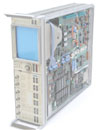 |
|
|
Use your scrollwheel to zoom in/out
--
Click and drag to view other parts of the image when zoomed |
|
|
|
Top-Inside View of the 1980B Oscilloscope
|
Zvonko Fazarinc, One Among Very Few, EXTRA ORDINARY PEOPLE
Throughout the 40 years of its publication, the monthly magazine "MEASURE" related the main events, and mentioned the employees who had left their mark on the life of the Hewlett Packard company. On very rare occasions, a particular article, entitled "EXTRA ORDINARY PEOPLE", celebrated some exceptional figures who had deeply marked the success of the company. Zvonko
Fazarinc is one of these, and reading the article published in July 1988, reproduced below, gives a better understanding as to the dimension of the character. The work on electronic circuitry simulation done by Zvonko in the sixties, on first generation HP computers, initiated the present electronic modelling software in general, and SPICE in particular.
 |
Article Published in MEASURE Magazine July/August 1988
Courtesy of the Hewlett Packard Company |
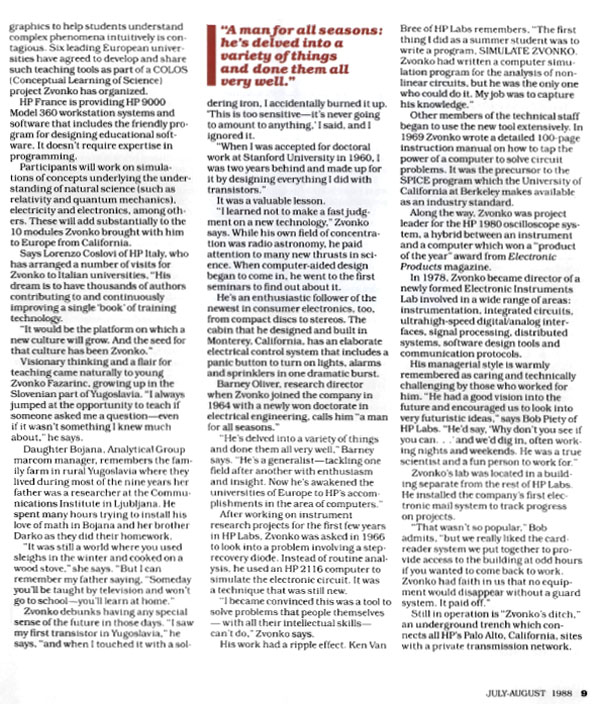 |
Article Published in MEASURE Magazine July/August 1988
Courtesy of the Hewlett Packard Company |
 |
Article Published in MEASURE Magazine July/August 1988
Courtesy of the Hewlett Packard Company |


